town life in medieval England
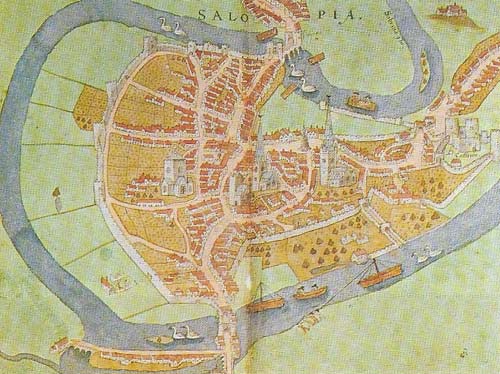
Figure 1. Shrewsbury, on a 16th-century map, appears crowded round its market square. The castle was first built in 1070 and the town obtained its first chartered in 1189. In the great period of medieval town life, before 1350, many towns outgrew their walls. The walls in most English towns were not built until the middle of the 12th century.
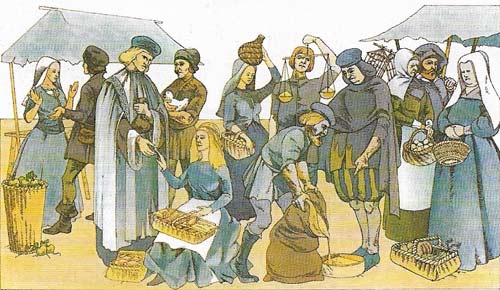
Figure 2. Markets were the life-blood of a medieval town, and they provided an outlet for peasants from the surrounding countryside to sell their own goods, as well as being the center for the inland distributive trade on more luxury products. They were situated in regular places in each town, often marked by a market cross or a covered hall. Markets could be violent places, and there were strict regulations governing them, particularly on the standards of goods sold. Towns hired officials such as the assayers of ale and bread, and offenders suffered heavy fines. A successful market could be an important source of profit for the town or the baron who set it up. The great period for the creation of market rights was the late 12th century.
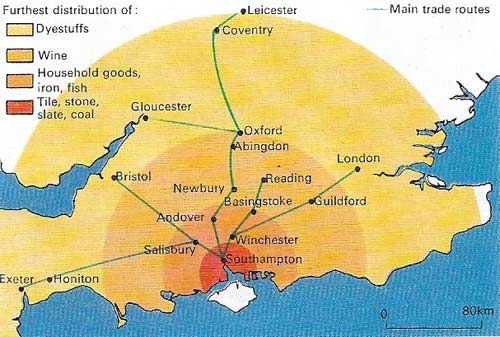
Figure 3. Southampton was an important town for both imports and exports in the Middle Ages. The network of roads was used to take these goods to inland towns. Goods from Southampton were found as far away as Leicester, 220 kilometers (137 miles) to the north, only valuable and easily carried goods were taken so far. The quality of the roads, particularly in winter, was not good, and although the trading towns tried to ensure that bridges on the vital routes were kept in good repair, responsibility for road upkeep was in the hands of each parish. As a result, many goods were carried baby water whenever possible.
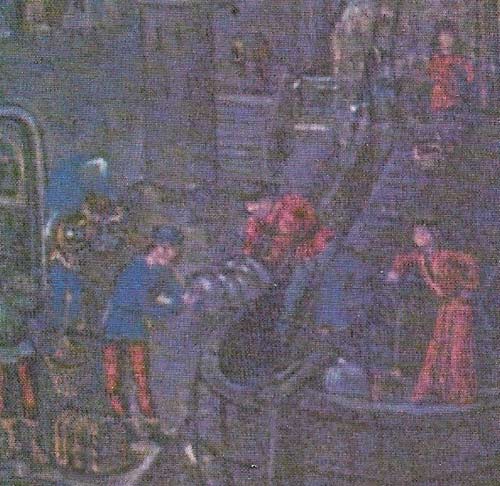
Figure 4. The export of wool was vital to the economy of many towns on the early Middle Ages, because the Flemish cloth industry came to rely on English wool on the 13th century. But when the English cloth industry itself grew up, based largely on villages, many towns contracted. On the 15th century several towns, such as Bradford in Yorkshire and Devizes on Somerset, prospered on cloth, but most of the towns that had grown in the 13th century now stagnated. Their political importance declined as the economy faded after 1400 and political hegemony reverted to nobility. Henry VII tried to revitalise town life after 1485 by stimulating trade overseas.
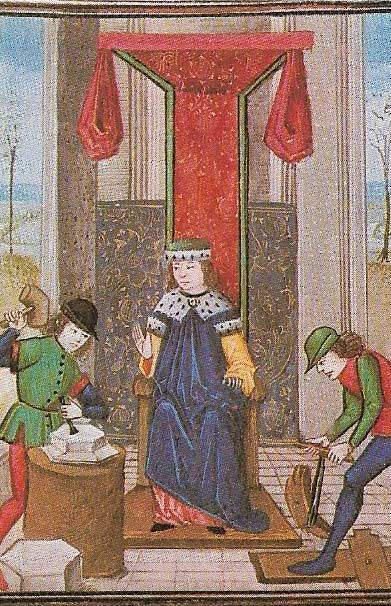
Figure 5. The craft guilds held examinations for apprentices before they were admitted to the guild as master craftsmen. Apprentices were required to learn their craft for seven years, and after qualifying they served as journeymen, travelling the country until they could afford to set up in business permanently. One of the most important functions of the craft guilds in the early 14th century was to maintain the standard of workmanship, and they adopted the concept of examinations from the universities. During the 15th century, when many towns were in decline, guilds generally tried to limit the number of apprentices by restricting entry to the sons of existing craftsmen.
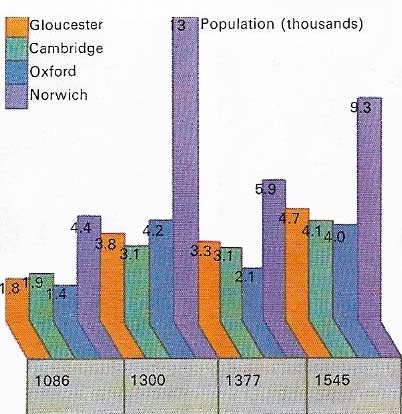
Figure 6. The population of medieval towns is hard to determine exactly, but it is clear that most towns lost a half of their population in the Black Death. This fall was only slowly reversed in the later Middle Ages.
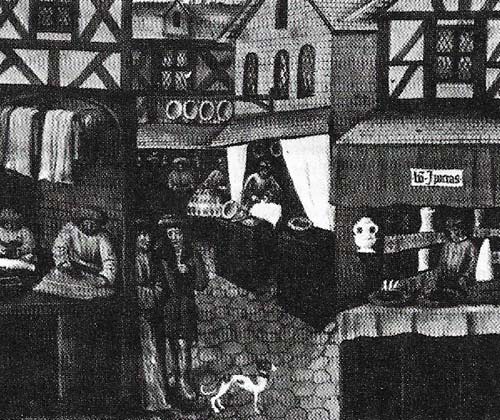
Figure 7. English medieval towns were often as crowded as this illustration of Paris suggests. The shops were little more than market stalls, and each trade was concentrated into a specific street. Most stable towns grew out of markets; others, relying on single industries, were liable suddenly to expand or disappear.
Town life in England reemerged in the 10th and 11th centuries after being practically non-existent since the departure of the Romans in the early 5th century. The medieval towns, especially London, were important as centres of trade and production and were also the cradles of a sophisticated non-feudal political consciousness.
The earliest towns
There were a number of towns in England before 1066 which formed part of the 10th-century kings' coherent plan of local government and defence. They were often planned towns: excavations at Winchester have revealed the grid plan of the tenth-century streets, and it seems that Oxford was consciously populated in about 910 by drafting villagers in from nearby communities. Although they were really fortified villages rather than towns, with agriculture far more important than industry, towns were nevertheless the means by which a measure of peace and government was imposed.
Some 52 "towns" were described in the Domesday Book (1086). In the twelfth century, growing international trade and a rising standard of living combined to multiply their number and to give birth to new crafts. The negotiatores (general traders) of the past gave way to specialized occupations organized in guilds. The purveyors of luxury goods, the vintners, goldsmiths and pepperers, were the earliest specialized trades in London. By 1191 representatives of a score of different trades witnessed a charter at Oxford, only a middle-sized town. Guilds enabled the towns to maintain their supplies and markets. Smaller towns began with a single "guild merchant" of all the trades, but during the 13th century humbler craft guilds (Figure 5), of weavers, bakers, fishmongers or smiths also emerged to claim their share in city government. These craft guilds looked after their members' interests whereas the guilds merchant organized the fundamental trading and market privileges of the towns (Figure 2).
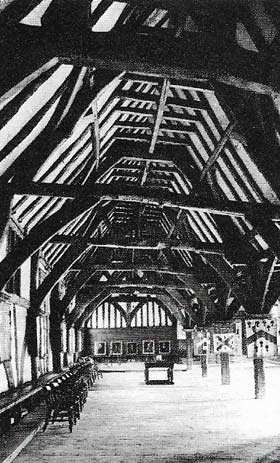 |
| The Guildhall of the Merchant Adventurers at York was built in about 1360 and served as a meeting place for the guild. The Merchant Adventurers became one of the greatest guilds in York as the trade in cloth overtook that in wool in the later Middle Ages. Cloth exports, unlike wool, were not bound to any staple and a merchant community emerged, ousting the foreign traders from their control of the business. Like most other guilds, the Merchant Adventurers was not purely economic in function, but had a partly religious and charitable purpose, because it undertook to support any of its members who became destitute. By the 15th century, the guild had many branches throughout the Low Countries. |
Life in the towns
Crowded sites soon made necessary a new style of life: closed street frontages, houses with their narrow ends to the street stretching far back into their gardens, created the town house and the modern townscape (Figures 1 and 7). Warehouses, counting-houses, shops and living-rooms shared many cramped sites in burgeoning towns such as Southampton. The streets themselves were narrow, because space was valuable: ordinances frequently forbade householders to encroach upon them. Open gutters in the middle of streets carried much refuse, although nearly every house had a cesspit as well. By 1300 town authorities were beginning to improve sanitary conditions: paviours were engaged to restore the surface of the streets, and butchers were generally forbidden to slaughter livestock except in "shambles" situated safely beyond the walls.
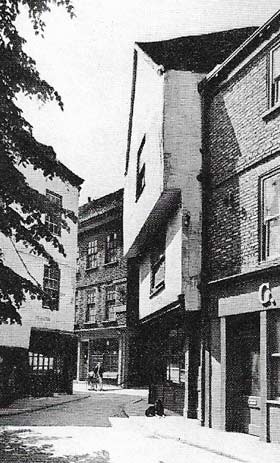 |
| The Shambles, is one of the few remaining medieval streets in England. It was originally devoted to butchers' shops. Despite legislation that butchers should only work outside the towns, the regulations, as here, were often ignored. |
The new communities where men could suddenly rise to great wealth and which had relative political freedom were naturally conscious of their difference from the more static rural society. At first they were dominated by small oligarchies made up of men in the luxury trades who had great influence at court. In their confident hands London and Oxford tried in 1191 to become communes independent of the surrounding shires, and many towns had mayors, aldermen, a common council and a town clerk by the middle of the thirteenth century.
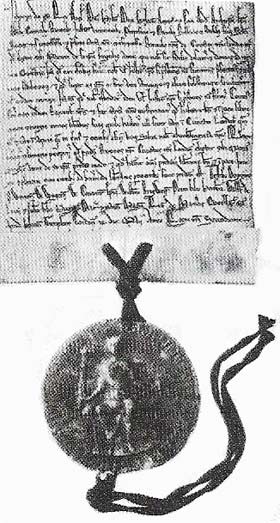 |
| John granted a charter of incorporation to London, England's largest town, in 1215. From the mid-12th century, London's citizens, who claimed even the right to elect the king, were seeking and winning privileges of self-government. John's charter confirmed the citizens' liberties and permitted the election of a mayor. |
But just as remarkable as the emergence of these towns was their vitality and tenacity in the face of radical social change. In the late thirteenth century the great urban oligarchies in London, Lincoln, York and other towns were swamped by the practitioners of the lesser guilds, many of whom were immigrants from the country. But although they displaced the old families, sometimes violently, these new families everywhere maintained and developed the old privileges, traditions and organizations of the towns.
Social unrest in the towns
Urban upheavals were common, especially after 1300. Many towns such as Louth and Stamford, dependent on their production of cloth, declined into small market towns when the introduction of the fulling mill made it more practical to make woollen cloth in the villages. The Black Death (1348–1350) hit especially hard at the densely packed towns. A general movement of wealth and population from the Midlands to East Anglia and the south-west left behind the shells of once prosperous communities: at Oxford falling house rents after 1325 attest the declining population (Figure 6). English towns were spared the violence of 14th-century Ghent or Florence, but the rising of the peasants in 1381 found allies in York, Norwich, and especially in London. And thieves at all times could find a ready refuge in the slums outside the city walls.
Only London could muster a mob with the violent potential of the urban masses in Paris or other European towns, but on several occasions in the late fourteenth century that London mob proved able to frustrate the government. Fora few days in 1381, in association with the peasants led by Wat Tyler (died 1381), it managed to render the government completely powerless. Urban life in England was precarious, yet it remained attractive. Trade, law, and government itself could not function without towns, and by 1500 they had become a vital element in all other English institutions.
